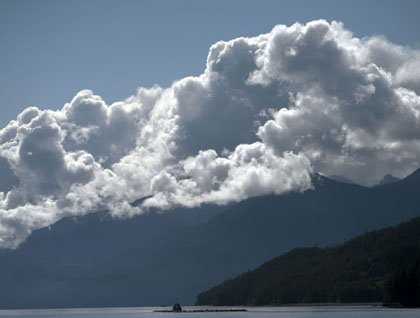A gorgeous sunrise found the National Geographic Sea Lion cruising in the northern end of Johnstone Strait, a main channel running through the Inside Passage. To the east the sun was decorating the mainland of British Columbia with mysterious shadows, while to the west the inside coast of Vancouver Island was illuminated by early morning light. There were staff on the bow on whale watch while many of us relaxed and enjoyed another day of light breezes and sunshine as we continued our journey north. In the late morning, Sharon Grainger gave a presentation on the people, culture and art of the Northwest Coast. From her perspective we got a glimpse of life along this nutrient rich coastline. Through images we saw the furtive and dramatic landscape of the Northwest Coast where there is a strong connection between the land, art and tools, all of which provide the perfect materials and backdrop for the foundation of a complex culture and art form. This is expressed in paintings, carvings, weavings, making of button blankets and the building of Big Houses. In the Big Houses stories are told about the first encounters each family member had with the first natural and super natural beings...those creatures who shape shift and move either in shadow, fly overhead and swim in the sea. These stories are depicted in crests owned and passed on by families which remind each family member, clan and group of who they are and where they come from.
As if on call we heard the radios begin to chatter...Killer whales had been spotted! We were all called to the bow to watch a group of northern residents as they made their way along the inside of Vancouver Island in Johnstone Strait. A small group of 4 or 5 whales dove, surfaced and moved close to the shoreline. One younger animal was seen again and again, surfacing very close to its mother. Killer whales are matrilineal and this group was probably a matriline or small group of Killer whales with one female as the central figure. They remained with us for the entire morning casually taking their time while moving north in the same direction as the Sea Lion.
Lunch was served early while our vessel tied up at the government dock in the small community of Alert Bay located on Cormorant Island. Once secured, we had a chance to go ashore and visit a very old community graveyard where totem poles have been erected for over a hundred years. Two new memorial poles went up last winter and this only added to the continuum of a living culture of this First Nations community. From this photo opportunity many of our group took advantage of a mile walk to the U’mista Cultural Center where our afternoon visit would begin.
Once inside U’mista our group was divided into two groups and our host Lillian Hunt, a lifelong First Nations resident of Alert Bay was our interpreter. Through the main hallway of the museum, we made our way into the lower gallery which holds a very important collection of potlatch regalia. Lillian walked each group through the coppers and masks, sharing the stories and importance of each piece. She also explained the importance of the repatriation of these pieces which were confiscated by the Canadian government in 1921 when a Cranmer family potlatch was raided on Village Island. Government officials told the people of Alert Bay, “Build a museum and we will return your pieces to you.” U’mista means a form of ransom in Kwakwala, hence the affectionate name for the U’mista cultural center which was given by elders in the community and remains to this day, “the box of treasures.”
After our visit to the U’mista cultural center we were invited to the gukwdzi, or Big House, by the Tsasala Cultural Group. As is the tradition amongst First Nations we were not only guests, but also witnesses to an exhibition of traditional drumming, singing and dancing. As the first young dancers entered the main floor of the Big House in a welcome dance, we saw the meaning in the tradition of holding children as our greatest resource. Shafts of late afternoon light came through the smoke hole and those rays were decorated in patterns from the smoke. The rays reached to the floor and touched the heads of many of the dancers, while eagle down floated in the air. A visual feast was before us all, mixed with the sounds and song from the drum log, a living culture unfolding before our eyes as the continuum of the Northwest Coast culture and life continues into the future.









